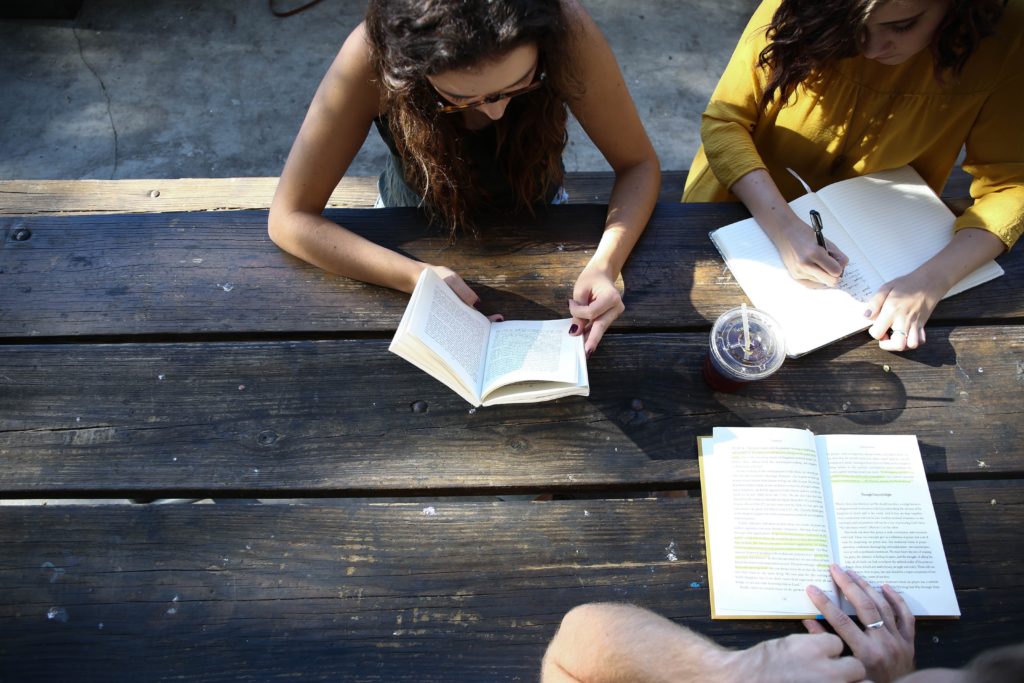The Role of Student Voices on State Boards of Education

The photo includes three young people reading together outside at a wood-slat picnic table. The photographer captured the scene from above to focus the viewer’s attention on the subjects’ acts of reading. Two young people with long dark hair are at the top center and right of the frame, and the third subject is located at the bottom right of the frame with only part of the subject’s arm and hand showing next to the book resting on the table. Photo by Alexis Brown on Unsplash.
Did you know that of the 54 states and territories tracked by the National Association of State Boards of Education, 50 have boards of education (BOE) responsible for setting education policy? And 24 of those include student representatives as members of their state boards of education? We didn’t, so we were interested to learn that in six of those states and territories, student representatives serve as voting members; in 17, students are nonvoting members. Vermont is unique with one voting and one nonvoting student member.
AEP has been working to include youth voices in our work, but it’s been difficult because our organization is removed from direct work with students. However, as a policy organization, we were interested in connecting with student representatives that serve on their state boards of education. The State Relations Team from our parent organization, Education Commission of the States, helped us to identify states with strong student representative programs. After contacting those states, we were matched with Casey Maddock from Maine, who answered some questions about her work as a student representative.
Tell us about yourself, including your role on your state’s board of education.
I am a senior in high school in southern Maine. I was nominated to be on the Maine State Board of Education at the end of my sophomore year and confirmed shortly thereafter. In Maine, student members are nonvoting but encouraged to participate as much as possible, and they may join and participate in committees as they wish. During my first year, I partnered with my fellow student representative Jaylee Rice and Maine Education Commissioner Pender Makin to form and co-chair the student advisory cabinet. These duties are now part of the role of student representatives here in Maine.
What duties do you have as a student representative to the board?
I’m not a voting member, but I participate in the certification and higher education committee, as well as the legislative action committee when my schedule allows. As I mentioned, I also co-chair the student advisory cabinet.
What have been your experiences so far in arts education, both in school and outside of school?
In school, I have been in the Scarborough band program since fifth grade. I played trombone and then euphonium. Outside of school, I am a competitive dancer with Scarborough Dance Center. I truly love being on stage and plan to continue dancing at university.
How has your time on the board of education been the same as you expected? Different? Have there been any surprises?
Obviously COVID-19 has thrown a wrench into a lot of my expectations, but otherwise it has been an incredibly educational experience just as I had imagined.
If you could suggest changes to the student representative role for the future, what would they be?
One of my hopes for the future is that student representatives in Maine will be able to vote. I have always found it strange that they can’t, and my goal is to make this happen for my successors.
What have you learned from your time on the board of education that you’d like to carry forward?
One thing I’ve learned from my time on the BOE is the importance of assuming positive intentions. Most of the time, people are very quick to call out lawmakers and public servants for causing harm. I have learned that people — at least those I work with — often have the best intentions at heart and might even be on track to ameliorate the public’s problems. The main obstacle is not getting them to do the right thing; it is simply the delays and confusions of bureaucracy.
What are your hopes for changes for students in your state in the future?
I would love to see students have more opportunities to personalize their education at younger ages. I think students should be able to more deeply explore subjects that relate to careers they are interested in. This might look like more flexibility for students who want to pursue career and technical education, more advanced visual and performing arts, and much more. I think many school districts try to pump out what they perceive as “traditional” college applicants. The heaviest focus is on SAT and Advanced Placement scores rather than what would best prepare students for their own future.
From your perspective, what policy possibilities exist that we’re not already taking advantage of?
The Maine Department of Education website states that the department “is committed to supporting schools in the delivery of quality and effective PreK-12 visual and performing arts instruction.” However, the availability of arts classes varies from district to district. I would love to see more funding devoted to minimizing these variations across the state and providing equitable opportunities for students no matter where they live.



